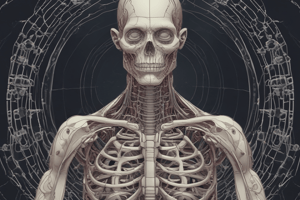Podcast
Questions and Answers
What is the smallest unit of matter?
What is the smallest unit of matter?
- Molecules
- Cells
- Atoms (correct)
- Organelles
What is a group of atoms that work together?
What is a group of atoms that work together?
- Cells
- Organs
- Tissues
- Molecules (correct)
What is the basic unit of life?
What is the basic unit of life?
- Cells (correct)
- Atoms
- Tissues
- Molecules
What is an example of an organ system?
What is an example of an organ system?
What is the level of organization that comprises a group of organs working together?
What is the level of organization that comprises a group of organs working together?
What is an example of a cardiomyocyte?
What is an example of a cardiomyocyte?
What is the study of biological cells and tissues called?
What is the study of biological cells and tissues called?
What is the highest level of organization in the human body?
What is the highest level of organization in the human body?
What is the primary function of epithelial tissue?
What is the primary function of epithelial tissue?
Which of the following tissue types is responsible for producing movement?
Which of the following tissue types is responsible for producing movement?
What is the primary function of nervous tissue?
What is the primary function of nervous tissue?
What is the primary function of connective tissue?
What is the primary function of connective tissue?
How many primary tissue types are there in the human body?
How many primary tissue types are there in the human body?
Which of the following is NOT a primary tissue type?
Which of the following is NOT a primary tissue type?
What is the main role of muscle tissue?
What is the main role of muscle tissue?
Which tissue type is responsible for facilitating exchange of substances between the cell and its environment?
Which tissue type is responsible for facilitating exchange of substances between the cell and its environment?
What is a chemical element defined as?
What is a chemical element defined as?
What are the four primary tissue types?
What are the four primary tissue types?
What is the estimated number of cells in the human body?
What is the estimated number of cells in the human body?
What are the three macromolecules identified on a food label?
What are the three macromolecules identified on a food label?
What are the two types of nucleic acids?
What are the two types of nucleic acids?
What is the function of electrolytes in the body?
What is the function of electrolytes in the body?
What is the term for a substance that can be broken down by chemical reactions?
What is the term for a substance that can be broken down by chemical reactions?
What is the approximate number of fat cells in the human body?
What is the approximate number of fat cells in the human body?
What is the primary focus of anatomy in the human body?
What is the primary focus of anatomy in the human body?
What is the primary objective of studying the levels of organisation in the human body?
What is the primary objective of studying the levels of organisation in the human body?
What is the relationship between anatomy and physiology?
What is the relationship between anatomy and physiology?
What is the primary focus of physiology in the human body?
What is the primary focus of physiology in the human body?
What is the purpose of the independent learning activity on LEO?
What is the purpose of the independent learning activity on LEO?
What is the primary focus of the learning objectives in this lecture?
What is the primary focus of the learning objectives in this lecture?
Flashcards are hidden until you start studying
Study Notes
Scientific Terminology and Body Organisation
- Anatomy is the study of internal and external body structures, and the physical relationships between body parts.
- Physiology is the study of the functions of the anatomical structures both individually and as a group.
- Histology is the study of biological cells and tissues.
Levels of Organisation
- Chemical (or molecular) level: the smallest chemical units of matter, including atoms, molecules, and ions.
- Examples of atoms: hydrogen (H), carbon (C).
- Example of a molecule: H2O (2 atoms of hydrogen + 1 atom of oxygen).
- Cellular level: a group of atoms, molecules, and organelles working together, and the basic unit of life.
- Example of a cell: cardiomyocyte (cardiac muscle cell).
- Tissue level: a group of similar cells working together.
- Organ level: a group of different tissues working together.
- Organ system level: a group of organs working together, with 11 organ systems in the human body.
- Organism level: a human is an organism.
Introduction to Chemistry
- Elements: substances that cannot be further broken down by any chemical reaction.
- Major elements: elements that make up the majority of the human body.
- Ions and electrolytes: charged particles that are important for various bodily functions.
Macromolecules
- Three main macromolecules: fats (lipids), carbohydrates, and proteins.
- Nucleic acids: the fourth macromolecule, including Ribonucleic acid (RNA) and Deoxyribonucleic acid (DNA).
Cells
- Approximately 37.2 trillion cells in the human body.
- Cell numbers vary in health and disease.
- Examples of cells: fat cells (50 billion), heart muscle cells (2 billion).
Tissues
- Four primary tissue types: epithelial, connective, muscle, and nervous tissue.
- Epithelial tissue: facilitates exchange of substances between the cell and its environment.
- Connective tissue: connects, supports, and anchors various body parts.
- Muscle tissue: produces movement.
- Nervous tissue: relays messages from one part of the body to another.
Studying That Suits You
Use AI to generate personalized quizzes and flashcards to suit your learning preferences.



